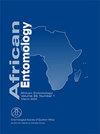阿尔及利亚Cedar Processionary蛾的天敌Thaumetopoea bonjeani(鳞翅目:齿蛾科)
IF 1.2
4区 农林科学
Q3 ENTOMOLOGY
引用次数: 1
摘要
雪松行进蛾Thaumetopoea bonjeani(Powel)(鳞翅目:Notodontidae)是北非阿特拉斯雪松林的破坏性落叶昆虫之一(Démolin 1988;Mouna 2013;Battisti等人2015;Rahim等人2016;El Mokhefi等人2021)。众所周知,邦杰尼塔姆托波亚在阿特拉斯雪松上是单食性的,该雪松适应高海拔/高海拔。该物种于1986年被列入阿尔及利亚动物群(Démolin 1988)。雪松加工蛾的负面影响至少可以从两个方面来看待。落叶会减少木材生长,也会导致木材干燥(Rahim 2016)。感染也可能对人类有害,导致皮肤损伤(即荨麻疹或皮炎)、结膜炎和呼吸道症状,甚至过敏性休克(Battisti等人,2017)。雪松行进蛾的种群,和许多其他以树叶为食的森林昆虫一样,表现出周期性的渐变或种群周期。例如,在阿尔及利亚北部的久尔朱拉森林,自2010年以来,大量落叶导致雪松枯死(Rahim 2016)。密度增加的原因尚不清楚,尽管可以推测这些遗迹林分对非生物(天气)和生物(天敌)因素的变化的缓冲作用较小。许多植食性昆虫的种群在很大程度上由它们的天敌决定(Price等人,1980;Wallner,1987年)。例如,寄生蜂和捕食者在卵批阶段降低T.bonjeani的种群密度方面发挥着重要作用(Rahim等人,2016)。然而,人们对T.bonjeani在幼虫和蛹阶段的天敌,以及它们在种群调节中可能发挥的作用知之甚少。我们调查了久尔朱拉国家公园(36°39'N 4°01'E)、阿特拉斯雪松天然林(树龄:20–90年)中T.bonjeani的天敌。该公园位于阿尔及利亚阿尔及尔东南140公里处,海拔约1600米,气候亚湿润。收集了2014年和2015年的T.bonjeani幼虫和蛹。本研究收集了约20个月龄的斑蝶幼虫。两年的4月至7月为两周一次的间隔期,与幼虫发育期相对应。前四龄幼虫被收集到树干上1-3米处,然后被带到实验室(22±2°C),在那里它们被饲养在透明的塑料容器(26.5×13.5×7.5厘米)中,并喂食大西洋雪松针。五龄幼虫在开始化蛹时被收集起来,并放置在装有土壤的容器中,在30±2°C下饲养。每隔一天对这些容器进行一次检查,看是否有寄生蜂出现。在这两年的研究中,Thaumetopoea bonjeani蛹都是在8月份采集的。将收集到的蛹单独放置在用棉塞封闭的玻璃管(直径70毫米×9毫米)中,直到出现寄生蜂或成虫。分离存在外部菌丝体的死蛹进行真菌病原体鉴定。在两年的采样过程中,观察到的所有捕食或以邦杰尼T.bonjeani幼虫和蛹为食的昆虫都被仔细收集,并转移到实验室,以确保每个天敌都以该害虫的一个或多个生物阶段为食。2014年4月至2015年8月,通过在白天进行的16次实地考察,评估了捕食者的身份。识别和/或确认本文章由计算机程序翻译,如有差异,请以英文原文为准。
Natural Enemies of the Cedar Processionary Moth, Thaumetopoea bonjeani (Lepidoptera: Notodontidae) in Algeria
The cedar processionary moth, Thaumetopoea bonjeani (Powel) (Lepidoptera: Notodontidae) is one of the damaging defoliators of Atlas cedar forests in North Africa (Démolin 1988; Mouna 2013; Battisti et al. 2015; Rahim et al. 2016; El Mokhefi et al. 2021). Thaumetopoea bonjeani is known to be monophagous on Atlas cedar which is adapted to high elevation/altitude. This species was included in the fauna of Algeria in 1986 (Démolin 1988). The negative impact of cedar processionary moth can be regarded in at least two aspects. Defoliation reduces wood growth and can also lead to drying of the wood (Rahim 2016). Infestations can also be harmful to humans, causing skin lesions (i.e. urticaria or dermatitis), conjunctivitis and respiratory symptoms or even anaphylactic shock (Battisti et al. 2017). Populations of the cedar processionary moth, like many other foliage-feeding forest insects, exhibit periodic gradations or population cycles. For example, in Djurdjura Forest in northern Algeria, heavy defoliation caused cedar tree dieback since 2010 (Rahim 2016). The reasons of the increase in density are unknown, although one can speculate that these relic stands are less buffered against changes of both abiotic (weather) and biotic (natural enemies) factors. The populations of many phytophagous insects are largely determined by their natural enemies (Price et al. 1980; Wallner 1987). For example, parasitoids and predators play an important role in reducing the population density of T. bonjeani in egg batch stages (Rahim et al. 2016). However, little is known of the natural enemies of T. bonjeani at larval and pupal stages, or what role they might play in the regulation of populations. We investigated the natural enemies of T. bonjeani in the Djurdjura National Park (36°39’N 4°01’E), in natural stands of Atlas cedar (age of trees: 20–90 years). The park is 140 km southeast of Algiers, Algeria, approximately 1600 m above sea level and with a sub-humid climate. Collections were made of larvae and pupae of T. bonjeani in 2014 and 2015. All larval instars of T. bonjeani were collected at about. biweekly intervals from April to July in both years, corresponding to the larval development period. The first four larval instars were collected to 1–3 m up a tree trunk, and then taken to the laboratory (at 22 ± 2 °C) where they were reared in clear plastic containers (26.5 × 13.5 × 7.5 cm) and fed Cedrus atlantica needles. The fifth-instar larvae were collected when they began their procession that would result in pupation and placed in containers containing soil, and reared at 30 ± 2 °C. The containers were checked every other day for parasitoid emergence. Thaumetopoea bonjeani pupae were collected during August in both years of the study. The pupae that were collected were placed individually in glass tubes (70 mm × 9 mm diameter) closed with cotton plugs, until parasitoids or adult moth emerged. Dead pupae with the presence of external mycelium were separated for fungal pathogen identification. All insects observed hunting or feeding on larvae and pupae of T. bonjeani during the two years of sampling were collected carefully, and transferred to the laboratory to make sure that each natural enemy fed on one or several biological stages of the pest. The identity of the predators was assessed through observations made during daytime on a total of 16 field visits in April–August 2014 and 2015. Identification and/or confirmation
求助全文
通过发布文献求助,成功后即可免费获取论文全文。
去求助
来源期刊

African Entomology
生物-昆虫学
CiteScore
2.00
自引率
0.00%
发文量
17
审稿时长
6-12 weeks
期刊介绍:
African Entomology (ISSN 1021-3589 – print / 2224-8854 – online) replaced the old Journal of the Entomological Society of Southern Africa in 1993. A single volume consisting of two issues (March and September) is published annually. The journal is indexed in all major abstracting journals
African Entomology is a peer reviewed scientific journal that publishes original research articles and short communications on all aspects of entomology, with an emphasis on the advancement of entomology on the African continent.
 求助内容:
求助内容: 应助结果提醒方式:
应助结果提醒方式:


